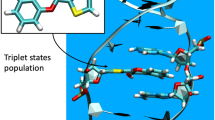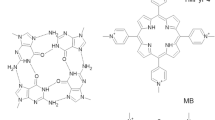Abstract
Time-resolved fluorescence of 3-methylbenzimidazole (m3B) was used to study stacking interaction between base moieties in di-, tri- and tetra-phosphate analogues of 3-methylbenzimidazolyl(5′-5′)guanosine (m3Bp n G, n = 2, 3, 4), using 5′-triphosphate of 3-methylbenzimidazole riboside (m3BTP) as reference. Fluorescence intensity decays of all compounds cannot be satisfactory fitted with single-exponential function. Although an increase of a number of exponents led to better fits, interpretation of the individual exponential terms, i.e. pre-exponential amplitudes and fluorescence lifetimes, cannot be adequately characterized. We show that these fluorescence decays are best fitted by power-like function derived from physically justified distribution of the fluorescence lifetimes, and characterized by the mean value of the excited-state lifetime and relative variance of lifetime fluctuations around the mean value. The latter led to the parameter of heterogeneity and number of decay paths, which depend on the factors responsible for non-radiative decay of the excited state, including base–base stacking interaction. This was studied by means of changes of temperature and the number of phosphate groups in dinucleotides. It was shown that the strongest effect of stacking interactions, characterized by lowest values of both fluorescence mean decay time and relative variance, occurs in the case of m3Bp3G containing the same number of phosphates as natural mRNA cap. The possible importance of these results for interpretation of the mechanism of function of the mRNA cap structure is discussed.



Similar content being viewed by others
Abbreviations
- m3B:
-
3-Methylbenzimidazole
- G:
-
Guanine
- m3BR:
-
3-Methylbenzimidazole-1-β-D-ribofuranoside
- m3BTP:
-
3-Methylbenzimidazole-1-β-D-ribofuranoside 5′-triphosphate
- m3Bp n G (n = 2, 3 and 4):
-
Di-, tri- and tetra-phosphate 3-methylbenzimidazolyl(5′-5′)guanosine
- m7G:
-
7-Methylguanine
- eIF4E:
-
Eukaryotic initiation factor
References
Biot C, Buisine E, Kwasigroch J-M, Wintjens R, Rooman M (2002) Probing the energetic and structural role of amino acid/nucleobase cation-π interactions in protein–ligand complexes. J Biol Chem 277:40816–40822
Blachut-Okrasinska E, Bojarska E, Niedzwiecka A, Chlebicka L, Darzynkiewicz E, Stolarski R, Stepinski J, Antosiewicz JM (2000) Stopped-flow and Brownian dynamics studies of electrostatic effects in the kinetics of binding of 7-methyl-GpppG to the protein eIF4E. Eur Biophys J 29:487–498
Brooks BR, Bruccoleri RE, Olafson BD, States DJ, Swaminathan S, Karplus M (1983) CHARMM: a program for macromolecular energy minimization and dynamics calculations. J Comput Chem 4:187–215
Carberry SE, Rhoads RE, Goss DJ (1989) A spectroscopic study of the binding of m7GTP and m7GpppG to human protein synthesis initiation factor 4E. Biochemistry 28:8078–8083
Chlebicka L, Wieczorek Z, Stolarski R, Stępiński J, Darzynkiewicz E, Shugar D (1995) Synthesis and properties of mRNA 5′-cap analogues with 7-methylguanine replaced by benzimidazole or 3-methylbenzimidazol. Nucleos Nucleot 14:771–775
Daugherty DA (1996) Cation-π interactions in chemistry and biology: a new view of benzene, Phe, Tyr, and Trp. Science 271:163–168
Długosz M, Wlodarczyk J (2004) The relationship between the kinetics of the excitation transport and the structure of an organic model compound by means of molecular dynamics and luminescence decay function analysis. In: Summer School on Advanced Modelling of Biological Function, Bremen, Germany
Dlugosz M, Blachut-Okrasinska E, Bojarska E, Darzynkiewicz E, Antosiewicz JM (2003) Effects of pH on kinetics of binding of mRNA-cap analogs by translation initiation factor eIF4E. Eur Biophys J 31:608–616
Furuichi F, Shatkin AJ (2000) Viral and cellular mRNA capping: past and prospects. Adv Virus Res 55:135–184
Gallivan JP, Dougherty DA (1999) Cation-π interactions in structural biology. Proc Natl Acad Sci USA 96:9459–9464
Hu G, Tsai A-L, Quiocho FA (2003) Insertion of an N7-methylguanine mRNA cap between two coplanar aromatic residues of a cap-binding protein is fast and selective for a positively charged cap. J Biol Chem 51:51515–51520
Jean JM, Hall KB (2004) Stacking–unstacking dynamics of oligodeoxynucleotide trimers. Biochemistry 43:10277–10284
Kozak M (2005) Regulation of translation via mRNA structure in prokaryotes and eukaryotes. Gene 361:13–37
Larsen OFA, van Stokkum IHM, de Weerd FL, Vengris M, Aravindakumar CT, van Grondelle R, Geacintov NE, van Amerongen H (2004) Ultrafast transient-absorption and steady-state fluorescence measurements on 2-aminopurine substituted dinucleotides and 2-aminopurine substituted DNA duplexes. Phys Chem Chem Phys 6:154–160
Levenberg KA (1944) A method for the solution of certain non-linear problems in least squares. Quart Appl Math II(2):164–168
Marcotrigiano J, Gingras AC, Sonnenberg N, Burley SK (1997) Cocrystal structure of the messenger RNA 5′ cap-binding protein (eIF4E) bound to 7-methyl-GDP. Cell 89:951–961
Marquardt DW (1963) An algorithm for least-squares estimation of nonlinear parameters. J Soc Ind Appl Math 11:431–441
Mathews MB, Sonenberg N, Hershey JWB (2000) Origins and principles of translation control. In: Sonenberg N, Hershey JWB, Mathews MB (eds) Translational control of gene expression. Cold Spring Harbor Laboratory Press, Plainview, New York, pp 1–32
Niedzwiecka A, Marcotrigiano J, Stepinski J, Jankowska-Anyszka M, Wyslouch-Cieszynska A, Dadlez M, Gingras A-C, Mak P, Darzynkiewicz E, Sonnenberg N, Burley SK, Stolarski R (2002) Biophysical studies of eIF4E cap-binding protein: recognition of mRNA 5′ cap structure and synthetic fragments of eIF4G and 4E-BP1 proteins. J Mol Biol 319:615–635
Nishimura Y, Takahashi S, Yamamoto T, Tsuboi M, Hattori M, Miura K, Yamaguchi K, Ohtani S, Hata T (1980) On the base-stacking in the 5′-terminal cap structure of mRNA: a fluorescence study. Nucleic Acids Res 8:1107–1119
O’Neill MA, Barton JK (2004) DNA charge transport: conformationally gated hopping through stacked domains. J Am Chem Soc 126:11471–11483
O’Neill MA, Becker HC, Wan C, Barton JK, Zewail AH (2003a) Ultrafast Dynamics in DNA-mediated electron transfer: base gating and the role of temperature. Angew Chem 47:6076–6080
O’Neill MA, Becker HC, Wan C, Barton JK, Zewail AH (2003b) Ultrafast dynamics in DNA mediated electron transfer: base gating and the role of temperature. Angew Chem Int Ed 42:5896–5900
Ruszczynska R, Kamienska-Trela K, Wojcik J, Stepinski J, Darzynkiewicz E, Stolarski R (2003) Charge distribution in 7-methylguanine regarding cation-π interaction with protein factor eIF4E. Biophys J 85:1450–1456
Saenger W (1984) Principles of nucleic acids structure. Springer, Berlin Heidelberg New York
Sonenberg N (1988) Cap-binding proteins of eukaryotic messenger RNA: functions in initiation and control of translation. Prog Nucleic Acid Res Mol Biol 35:173–207
Stolarski R, Zdanowski K, Chlebicka L, Wieczorek Z, Sitek A, Stepinski J, Jankowska M, Mattinen J, Temeriusz A, Darzynkiewicz E (1996) Inter- and intramolecular stacking of mRNA cap-analogues—relevance to initiation of translation. Collect Czech Chem Commun 61(special issue):217–221
Stoychev G, Kierdaszuk B, Shugar D (2001) Interaction of Escherichia coli purine nucleoside phosphorylase (PNP) with the cationic and zwitterionic forms of the fluorescent substrate N(7)-methylguanosine. Biochim Biophys Acta 1544:74–88
Su T-J, Connolly BA, Darlington C, Mallin R, Dryden DTF (2004) Unusual 2-aminopurine fluorescence from a complex of DNA and the EcoKI methyltransferase. Nucleic Acids Res 32:2223–2230
Tomoo K, Shen X, Okabe K, Nozoe Y, Fukuhara S, Morino S, Ishida T, Taniguchi T, Hasegawa H, Terashima A, Sasaki M, Katsuya Y, Kitamura K, Miyoshi H, Ishikawa M, Miura K (2002) Crystal structures of 7-methylguanosine 5′-triphosphate (m(7)GTP)- and P(1)-7-methylguanosine-P(3)-adenosine-5′,5′-triphosphate (m(7)GpppA)-bound human full-length eukaryotic initiation factor 4E: biological importance of the C-terminal flexible region. Biochem J 362:539–544
Tomoo K, Shen X, Okabe K, Nozoe Y, Fukuhara S, Morino S, Sasaki M, Taniguchi T, Miyagawa H, Kitamura K, Miura K, Ishida T (2003) Structural features of human initiation factor 4E, studied by X-ray crystal analyses and molecular dynamics simulations. J Mol Biol 328:365–383
Tsallis C (1988) Possible generalization of Boltzmann–Gibbs statistics. J Stat Phys 52:479–487; For updated bibliography on this subject see http://www.tsallis.cat.cbpf.br/biblio.htm; cf. also special issue of Braz J Phys 29 (1999) available at http://www.sbf.if.usp.br/bjp/Vol29/Num1/index.htm
Wieczorek Z, Zdanowski K, Chlebicka L, Stepinski J, Jankowska M, Kierdaszuk B, Temeriusz A, Darzynkiewicz E, Stolarski R (1997) Fluorescence and NMR studies of intramolecular stacking of mRNA cap-analogues. Biochim Biophys Acta 1354:145–152
Wilk G, Włodarczyk Z (1999) Interpretation of the nonextensivity parameter q in some applications of Tsallis statistics and Lévy distributions. Phys Rev Lett 84:2770–2773
Wlodarczyk J, Kierdaszuk B (2003) Interpretation of fluorescence decays using a power-like model. Biophys J 85:589–598
Wlodarczyk J, Kierdaszuk B (2005) Fluorescence decay heterogeneity model based on electron transfer processes in an enzyme-ligand complex. Acta Phys Pol A 107:883–894
Zemecnik P (1983) Diadenosine 5′,5-P 1, P 4 -tetraphosphate (Ap4A): its role in cellular metabolism. Anal Biochem 134:1–10
Acknowledgements
We are grateful to Dr. Lidia Chlebicka and Dr. Edward Darzynkiewicz (Department of Biophysics, Warsaw University) for the availability of methylbenzimidazole analogues. This investigation was supported by the Polish Ministry of Scientific Research and Information Technology (MNiI), grants no. 1P03B11128, and partially by 3P04A02425, BW-1605/BF and BST 975/BF.
Author information
Authors and Affiliations
Corresponding author
Rights and permissions
About this article
Cite this article
Kierdaszuk, B., Włodarczyk, J. Interpretation of intramolecular stacking effect on the fluorescence intensity decay of 3-methylbenzimidazolyl(5′-5′)guanosine dinucleotides using a model of lifetime distribution. Eur Biophys J 35, 424–430 (2006). https://doi.org/10.1007/s00249-006-0049-7
Received:
Revised:
Accepted:
Published:
Issue Date:
DOI: https://doi.org/10.1007/s00249-006-0049-7




